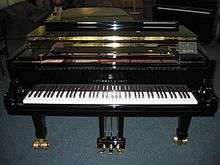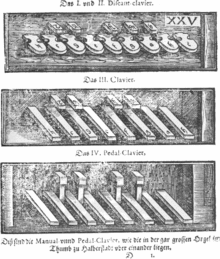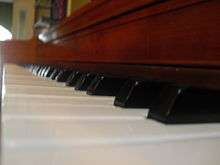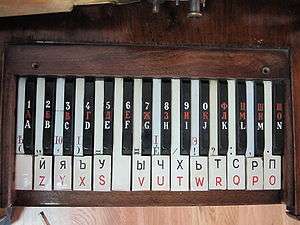Musical keyboard


A musical keyboard is the set of adjacent depressible levers or keys on a musical instrument. Keyboards typically contain keys for playing the twelve notes of the Western musical scale, with a combination of larger, longer keys and smaller, shorter keys that repeats at the interval of an octave. Depressing or striking a key on the keyboard makes the instrument produce sounds, either by making a hammer mechanically strike a string or metal tine (piano, electric piano, clavichord); pluck a string (harpsichord); open a valve to let air flow through a pipe (pipe organ or accordion); or strike a bell (a carillon in a church tower). On electric and electronic keyboards, depressing a key connects one or more circuits (Hammond organ, digital piano, synthesizer, MIDI controller keyboard), which triggers a musical sound. A pedal keyboard is a keyboard played with the feet, usually used with a pipe organ or theatre organ. Since the most commonly encountered keyboard instrument is the piano, the keyboard layout is often referred to as the "piano keyboard".
Musical keyboards can have as few as 12 keys, as in the case of the pedal keyboards used with spinet organs and some small bass synthesizers, 25 keys for small, 2010-era MIDI controller keyboards, 61 keys for many inexpensive home keyboards, 73 keys for professional electronic keyboards and 88 keys for an acoustic piano. Some keyboards have two "ranks" of keyboards, one stacked above the other, with the two keyboards referred to as the lower and upper manual, such as the Hammond organ, pipe organs and some harpsichords. Some pipe organs and theatre organs may have three keyboards. Keyboards that have multiple manuals typically give the player the option of using different "registrations" or sounds for each keyboard. Pedal keyboards have from 12 keys (home spinet organs) to 25 keys (many Hammond organs) to 32 or more (pipe organs in churches).
Description

The twelve notes of the Western musical scale are laid out with the lowest note on the left;[lower-alpha 1] The longer keys (for the seven "natural" notes of the C major scale: C, D, E, F, G, A, B) jut forward. Because these keys were traditionally covered in ivory they are often called the white notes or white keys. The keys for the remaining five notes—which are not part of the C major scale—(i.e.,C♯/D♭, D♯/E♭, F♯/G♭, G♯/A♭, A♯/B♭) (see Sharp and Flat) are raised and shorter. Because these keys receive less wear, they are often made of black colored wood and called the black notes or black keys. The pattern repeats at the interval of an octave.
The arrangement of longer keys for C major with intervening, shorter keys for the intermediate appeared in the 15th century. Many keyboard instruments dating from before the nineteenth century, such as harpsichords and pipe organs, have a keyboard with the colours of the keys reversed: the white notes are made of ebony and the black notes are covered with softer white bone. A few electric and electronic instruments from the 1960s and subsequent decades have also done this; Vox's electronic organs of the 1960s, Farfisa's FAST portable organs, Hohner's Clavinet L, one version of Korg's Poly-800 synthesizer and Roland's digital harpsichords.
Some 1960s electronic organs used reverse colors or gray sharps or naturals to indicate the lower part(s) of a split keyboard: one divided into two parts, each of which produces a different registration or sound. Such keyboards allow melody and contrasting accompaniment to be played without the expense of a second manual and were a regular feature in Spanish and some English organs of the renaissance and baroque. The break was between middle C and C-sharp, or outside of Iberia between B and C. Broken keyboards reappeared in 1842 with the harmonium, the split occurring at E4/F4.
The reverse-colored keys on Hammond organs such as the B3, C3 and A100 are latch-style radio buttons for selecting pre-set sounds.
Size and historical variation

The range of keyboard instruments has tended to increase over the centuries. Harpsichords often extended over five octaves (61+ keys) in the 18th century, while most pianos manufactured since about 1870 have 88 keys. Some modern pianos have even more notes (a Bösendorfer 225 has 92 and a Bösendorfer 290 "Imperial" has 97 keys). While modern synthesizer keyboards commonly have either 61, 76 or 88 keys, small MIDI controllers are available with 25 notes. (Digital systems allow shifting octaves, pitch, and "splitting" ranges dynamically, reducing the need for dedicated keys for the extreme lower or higher range.) Organs normally have 61 keys per manual, though some spinet models have 44 or 49. An organ pedalboard is a keyboard with long pedals that are played by the organist's feet. Pedalboards vary in size, with 32 notes (C-g') being endorsed by the AGO [1] and 12 notes often found on spinets.[2]
In a typical keyboard layout, black note keys have uniform width, and white note keys have uniform width and uniform spacing at the front of the keyboard. In the larger gaps between the black keys, the width of the natural notes C, D and E differ slightly from the width of keys F, G, A and B. This allows close to uniform spacing of 12 keys per octave while maintaining uniformity of seven "natural" keys per octave.
Over the last three hundred years, the octave span distance found on historical keyboard instruments (organs, virginals, clavichords, harpsichords, and pianos) has ranged from as little as 125 mm to as much as 170 mm. Modern piano keyboards ordinarily have an octave span of 164–165 mm; resulting in the width of black keys averaging 13.7 mm and white keys about 23.5 mm wide at the base, disregarding space between keys. Several reduced-size standards have been proposed and marketed. A 15/16 size (152 mm octave span) and the 7/8 DS Standard (140 mm octave span) keyboard developed by Christopher Donison in the 1970s and developed and marketed by Steinbuhler & Company. U.S. pianist Hannah Reimann has promoted piano keyboards with narrower octave spans and has a U.S. patent on the apparatus and methods for modifying existing pianos to provide interchangeable keyboards of different sizes.[3]
There have been variations in the design of the keyboard to address technical and musical issues. The earliest designs of keyboards were based heavily on the notes used in Gregorian chant (the seven diatonic notes plus B-flat) and as such would often include B♭ and B♮ both as diatonic "white notes," with the B♮ at the leftmost side of the keyboard and the B♭ at the rightmost. Thus, an octave would have eight "white keys" and only four "black keys." The emphasis on these eight notes would continue for a few centuries after the "seven and five" system was adopted, in the form of the short octave: the eight aforementioned notes were arranged at the leftmost side of the keyboard, compressed in the keys between E and C (at the time, accidentals that low were very uncommon and thus not needed). During the sixteenth century, when instruments were often tuned in meantone temperament, some harpsichords were constructed with the G♯ and E♭ keys split into two. One portion of the G♯ key operated a string tuned to G♯ and the other operated a string tuned to A♭, similarly one portion of the E♭ key operated a string tuned to E♭, the other portion operating a string tuned to D♯. This type of keyboard layout, known as the enharmonic keyboard, extended the flexibility of the harpsichord, enabling composers to write keyboard music calling for harmonies containing the so-called wolf fifth (G-sharp to E-flat), but without producing aural discomfort in the listeners (see: Split sharp). The "broken octave," a variation of the aforementioned short octave, similarly used split keys to add accidentals left out of the short octave. Other examples of variations in keyboard design include the Jankó keyboard and the chromatic keyboard systems on the chromatic button accordion and bandoneón.
Electric and electromechanical keyboards
The electric piano, of which a well-known example is the Fender Rhodes, has hammers that strike metal tines. Magnetic pickups pick up the vibrations of the tines. When plugged into a keyboard amp, it produces a loud enough sound to use in a jazz or rock band. The keyboard in the electric piano is still a mechanical device that strikes the sounding rod. It therefore possesses a "feel" similar to an conventional piano. Electronic organs and synthesizers create no audible sound themselves and the keyboard merely acts as a series of switches that connect electronic circuitry to produce tones. For example, a Hammond organ has rotating tonewheels and magnetic pickups that pick up the pitches. The Hammond's pickups are routed through an amplifier that drives the speakers. A Hammond is often used with an external rotating Leslie speaker. There, the rotating horn and woofer speaker baffle add a natural vibrato and chorus effect.
Electronic keyboards

Simple, inexpensive electronic keyboards designed for children and beginners are self-contained units with a keyboard, a sound module that imitates acoustic and synthesizer sounds, a small power amplifier, and a loudspeaker. These basic keyboards have switches under each key. Depressing a key connects a circuit, which triggers tone generation in an electronic sound module. The most basic, inexpensive keyboards use a keyboard matrix circuit, in which eight rows and eight columns of wires cross — thus, 16 wires can provide (8x8=) 64 crossings, which the keyboard controller scans to determine which key the player pressed.[4] The problem with this system is that it provides only a crude binary on/off signal for each key. Inexpensive keyboards may have as few as 25 keys. Some inexpensive Casio or Yamaha keyboards have 61 keys.
Better, more costly electronic keyboards, called touch sensitive or velocity sensitive keyboards, have two switches for each key, which close at different times in the key's travel. Determining the timing between the activation of the two switches gives the velocity of a key press, which the keyboard's electronics can use to produce softer sounds for soft touches and louder sounds for hard touches. In this way, an electronic keyboard can imitate the touch sensitive dynamics of a real acoustic instrument.
The best electronic keyboards have dedicated circuits for each key that providing polyphonic aftertouch. These keyboards detect continued pressure on a given key, which can trigger effects such as vibrato. More expensive keyboards may have more than 61 keys.
Advanced electronic keyboards may provide hundreds of key touch levels [5] and may have 88 keys, as most pianos do.
Categories
There are several categories of electronic keyboards.
- All-in-one: Many inexpensive and mid-priced electronic keyboards intended for amateur home use consist of a circuitry-connected keyboard with a synthesizer module or computer sound generating device, an amplifier and speakers, all incorporated into the keyboard's chassis. They typically have unweighted keys as a cost-saving measure. The least expensive models are not touch-sensitive, and only play one dynamic.
- Professional keyboards: Instruments such as the Clavia NORD series and clonewheel organs like the Roland VK-7 combine a circuitry-connected keyboard with a synthesizer module or computer sound generating device, but they do not contain an amplifier or speakers within the keyboard. The manufacturers intend these professional keyboards to be plugged into an external keyboard amplifier (a wooden cabinet that contains an amplifier and a speaker).
- Stage pianos: These are digital pianos with professional features such as weighted keys and a rugged chassis. They are designed for use by professional touring musicians and they are often used as the "house piano" in nightclubs and music festivals. Most stage pianos do not have an internal amp and speakers, so they have to be plugged into a keyboard amp. Unlike in-home digital pianos, stage pianos typically use an external sostenuto pedal and a separate keyboard stand (rather than a built-in stand). Stage pianos are designed this way to facilitate transport and touring use.
- MIDI controllers: These controllers do not make any sound by themselves. A MIDI controller keyboard only produces an electronic signal that a performer has depressed a certain key or keys. A MIDI controller must be connected to an electronic sound module (to generate musical sounds from the controller's output data), which in turn must be connected to a keyboard amplifier to make the sounds audible. The complexity of setting up MIDI controller systems and sound modules tends to limit their use to professionals or advanced amateurs. (Note: while there are a variety of types of MIDI controllers, such as wind controllers, keyboard MIDI controllers are by far the most common type of MIDI controller.)
Playing techniques
Despite their apparent similarity, keyboard instruments of different types require different techniques. With a piano, the piano hammer mechanism produces a louder note when the key is struck faster and harder, and a softer note when the key is pressed lightly and gently. In contrast, the harpsichord's plectrum mechanism does not perceptibly vary the volume of the note with different touch on the keyboard. The pipe organ's volume and timbre are controlled by the flow of air from the bellows and the stops preselected by the player. Pressing a pipe organ's keys harder or faster does not make the notes sound louder. Players of these instruments use different techniques on harpsichord and pipe organ, such as note length and changing the stops, to add expression to their playing. A 2015-era electronic arranger keyboard may be preset to produce any of a range of voices as well as percussion and other accompaniment patterns (e.g., an automatic bassline) that matches the chords played by the left hand.
Different keyboard instruments have different types of keyboards. An acoustic piano has wooden weighted keys, which high-end digital pianos and stage pianos imitate. Inexpensive electronic keyboards have lightweight, unweighted keys made from plastic. The variety of mechanical designs gives different keyboards different feels. Professional players must have training and experience with the different types of keyboard instruments to perform on them at a professional standard. Some keyboard students in music conservatories and universities study more than one style of keyboard playing. Keyboard players who aim to specialize in Baroque music (ca. 1600-1750) often study pipe organ and harpsichord. Each instrument has a different type of keyboard and different stops. A harpsichord may have stops that add additional octaves pressed keys, or a "lute stop" that imitates the sound of a lute. A pipe organ may have stops that octave pipes above and below each pressed key, a fifth above (the quintet stop), and stops that imitate wind instruments such as horns. Pipe organ players also learn to play the foot-operated pedal keyboard to play deep bass notes.
Some keyboard students preparing for a jazz performance career study both the acoustic piano and the Hammond organ. With the jazz example, each of these keyboard instruments requires a different playing technique and each has its own idioms and stylistic features that students must learn about. From a technical perspective, skilled acoustic piano students learning to play the Hammond organ can immediately play chord and scales, but must learn to use features not present on a piano: tone-controlling drawbars, two manuals (two rows of keyboards stacked stepwise), bass pedalboard played with the feet, use the volume pedal and operate the Leslie speaker, a rotating speaker horn with controls for rotation and speed that imparts expressive chorus effects.

Even though the keyboard layout is simple and all notes are easily accessible, playing requires skill. A proficient player has undertaken much training to play accurately and in tempo. Beginners seldom produce a passable rendition of even a simple piece due to lack of technique. The sequences of movements of the player's hands can be very complicated. Problems include wide-spanned chords, which can be difficult for people with small hands, chords requiring unusual hand positions that can initially be uncomfortable, and fast scales, trills and arpeggios.
Playing instruments with velocity sensitive (or dynamic) keyboards (i.e., that respond to varying playing velocity) may require finger independence, so that some fingers play "harder" while others play more softly. Keyboardists speak of playing harder and softer, or with more or less force. This may accurately describe the player's experience—but in the mechanics of the keyboard, velocity controls musical dynamics. The faster the player depresses the key, the louder the note. Players must learn to coordinate two hands and use them independently. Most music is written for two hands; typically the right hand plays the melody in the treble range, while the left plays an accompaniment of bass notes and chords in the bass range. Examples of music written for the left hand alone include several of Leopold Godowsky's 53 Studies on Chopin's Etudes, Maurice Ravel's Piano Concerto for the Left Hand and Sergei Prokofiev's Piano Concerto No. 4 for the left hand. In music that uses counterpoint technique, both hands play different melodies at the same time.
Other uses

A number of percussion instruments share the keyboard layout, although they are not keyboard instruments with levers that are depressed to sound the notes. Instead, the performer of instruments such as the xylophone, marimba, vibraphone, and glockenspiel strikes the separate-sounding tone bar of metal or wood for each note using a mallet. These bars are laid out in the same configuration as a common keyboard.
Some examples of a musical keyboard are used for non-musical devices. For example, some of the earliest printing telegraph machines used a layout similar to a piano keyboard.[6][7]
Keyboards with alternative sets of keys
Some rare variations of keyboards have more or fewer than 12 keys per octave. These are mostly used in microtonal music, after the discoveries and theoretical developments of musician and inventor Julián Carrillo (1875–1965).
Some free-reed instrument keyboards such as accordions and Indian harmoniums include microtones. Electronic music pioneer Pauline Oliveros plays one of these. Egyptian belly-dance musicians like Hassam Ramzy use custom-tuned accordions so they can play traditional scales. The small Garmon accordion played in the Music of Azerbaijan sometimes has keys that can play microtones when a "shift" key is pressed.

See also
Notes
- ↑ An exception is the hurdy-gurdy, whose crank is turned with the left hand.
References
- ↑ Standard console specifications. 30-note pedalboards are fairly usual in France.
- ↑ A few Iberian organs have only a two-note kettledrum effect played by foot.
- ↑ Reimann, Hannah: Patent claim #6,020,549, August 10, 1998
- ↑ Dave Dribin: "Keyboard Matrix Help", (June 24, 2000)
- ↑ Digital piano specs (100 pressure levels specified)
- ↑ George M. Phelps, U.S. Patent 0,026,003 Improvement in Telegraphic Machines issued November 1, 1859
- ↑ The House Printing Telegraph (image)
Further reading
- Bond, Ann (1997). A Guide to the Harpsichord. Amadeus Press. ISBN 1-57467-063-8.
External links
| Wikimedia Commons has media related to Musical keyboards. |
| Wikisource has the text of the 1911 Encyclopædia Britannica article Keyboard. |
- KeyLess Online, Western notes and Carnatic swaras laid out on the keyboard
- Keyboard Magazine, selections from magazine, along with multimedia examples
- Keyboard chords
- MathPages, mathematical discussion of the distribution of the keys
- "The Keyboard of a Harpsichord"